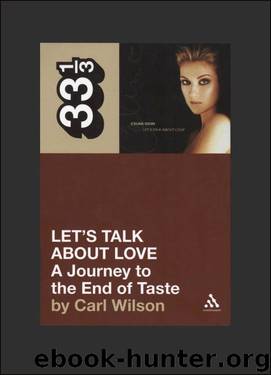Celine Dion's Let's Talk About Love: A Journey to the End of Taste by Wilson Carl

Author:Wilson, Carl [Wilson, Carl]
Language: eng
Format: epub
Publisher: Continuum US
Published: 2007-11-23T00:00:00+00:00
8.
Let’s Talk About Who’s Got Bad Taste
The poll I have in mind was conducted in the mid-1960s in France by a team of researchers under sociologist Pierre Bourdieu. It surveyed thousands of people on what kinds of culture they knew, liked and participated in—not just in the arts, but sports, hobbies, foods, styles of dress and furniture, the newspapers and TV programs they followed, etcetera. All this data was correlated with information about their incomes, education levels, family backgrounds and occupations, and supplemented with interviews in which people were asked to discuss and defend their preferences.
The result was a milestone of social science, Bourdieu’s 1979 tome Distinction: A Social Critique of the Judgement of Taste. Note the subtitle, a flip of the bird to Kant’s Enlightenment notion of disinterested aesthetic judgment: For Bourdieu, taste is always interested—in fact, self-interested—and those interests are social. His theories press the point that aesthetics are social all the way down, just a set of euphemisms for a starker system of inequality and competition: if you flinch at seeing a copy of Let’s Talk About Love or The DaVinci Code on a friend’s shelves, what you are trying to shake off is the stain of the déclassé, the threat of social inferiority.
What made him think so? His survey data had confirmed stereotypes to a staggering degree: almost exclusively, French people with working-class jobs knew and liked only relatively “lowbrow” culture; the middle classes liked “middlebrow” stuff; and the better-off were patrons of “highbrow” culture. Aesthetic and lifestyle choices even clustered along more minute divisions within classes: workers in factories had different tastes than workers in shopping centers; office managers differed from small-business owners; surgeons’ tastes were unlike those of corporate executives.
But it was in asking people the reasons behind their choices that Bourdieu exploded the assumptions embedded in the whole “brow” system (which originated in racist nineteenth-century theories about facial features and intelligence). What he found was that poorer people were pragmatic about their tastes, describing them as entertaining, useful and accessible. But from the middle classes up, people had much grander justifications. For one thing, they were far more confident about their dislikes, about what was tacky or lame. But they also spoke in elaborate detail about how their tastes reflected their values and personalities, and in what areas they still wanted to enrich their knowledge.
Bourdieu’s interpretation was that tastes were serving as strategic tools. While working-class tastes seemed mainly a default (serving at best to express group belongingness and solidarity), for everyone else taste was not only a product of economic and educational background but, as it developed through life, a force mobilized as part of their quest for social status (or what Bourdieu called symbolic power). What we have agreed to call tastes, he said, is an array of symbolic associations we use to set ourselves apart from those whose social ranking is beneath us, and to take aim at the status we think we deserve. Taste is a means of distinguishing ourselves from others, the pursuit of distinction.
Download
This site does not store any files on its server. We only index and link to content provided by other sites. Please contact the content providers to delete copyright contents if any and email us, we'll remove relevant links or contents immediately.
The Goal (Off-Campus #4) by Elle Kennedy(13608)
Kathy Andrews Collection by Kathy Andrews(11767)
Diary of a Player by Brad Paisley(7521)
What Does This Button Do? by Bruce Dickinson(6171)
Assassin’s Fate by Robin Hobb(6166)
Big Little Lies by Liane Moriarty(5748)
Altered Sensations by David Pantalony(5071)
Pale Blue Dot by Carl Sagan(4960)
Sticky Fingers by Joe Hagan(4148)
The Death of the Heart by Elizabeth Bowen(3581)
The Heroin Diaries by Nikki Sixx(3521)
Beneath These Shadows by Meghan March(3282)
Confessions of a Video Vixen by Karrine Steffans(3276)
How Music Works by David Byrne(3236)
The Help by Kathryn Stockett(3116)
Jam by Jam (epub)(3050)
Harry Potter 4 - Harry Potter and The Goblet of Fire by J.K.Rowling(3033)
Computational Linguistics and Intelligent Text Processing: 20th International Conference, CICLing 2019 La Rochelle, France, April 7â13, 2019 Revised Selected Papers, Part I by Alexander Gelbukh(2967)
Strange Fascination: David Bowie: The Definitive Story by David Buckley(2837)
